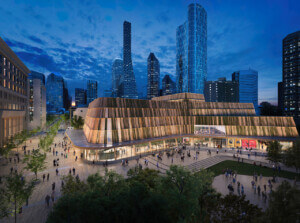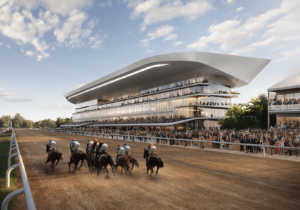The movie theater, RKO Keith’s, is one of the city’s only surviving “atmospheric” theaters built in the early 20th century. Abandoned since the mid-1980s, the opulent Churrigueresque structure’s interior was landmarked in 1984, though a series of owners did little over time to curtail extensive deterioration inside. Now, a new owner, Xinyuan Real Estate, has hired Pei Cobb Freed & Partners to transform the Flushing, Queens building into 16 stories of offices and apartments. (Last week AN contributor Edward Gunts covered the theater’s history and the current development.)
At a Tuesday meeting, the LPC voted unanimously to re-authorize a previously issued Certificate of Appropriateness to build out Pei Cobb Freed’s vision and undertake preservation work on the interior.
Plans call for retail and an apartment lobby to be built around the 1928 theater’s landmarked ticket lobby and grand foyer (the rest of the interior was initially landmarked, but its protections were removed by the Board of Estimate after an appeal by an owner). Significant architectural elements will be conserved, while those too damaged for conservation or missing will be replicated offsite and reinstalled in the theater. Those changes, the LPC said, will be reviewed and permitted at staff level.
Pei Cobb Freed is collaborating with New York–based historic preservation firm AYON STUDIO on the project. During the meeting, AYON founding principal Angel Ayón explained how steel trusses will span the landmarked interiors on the east-west and north-south axes to preserve the cavity as construction on the new building gets underway. When the architects have a new envelope, the team will be able to reinstall the plaster, woodwork, and new curtains. Ayón likened the work on the decorative features to the preservation of Times Square’s Lyric Theater, which underwent a similar process to remove and conserve ornamental plaster.
The LPC is working with the owner to make sure plaster gets put back in place. The two parties agreed to $10 million bond for storage and periodic inspection of the plaster, though the commission said those details still being hammered out. One major requirement of interior landmarks is that they remain open to the public. Patrick Waldo of preservation advocacy group Historic Districts Council (HDC), as well as Christabel Gough of the Society for the Architecture of the City, raised concerns about the accessibility of a space that fronts a future (private) apartment lobby. HDC “strongly” suggested the street entrance be re-examined to expose the interior more fully; at the very least, the group recommended strong wayfinding signage to alert the public to the presence of the landmark.
To get more insight into the theater’s place in New York history, Gunts reached out to Anthony Robins, a former senior preservation specialist at the agency who wrote the original designation report, for more on RKO Keith’s. Here’s what he had to say:
The recent history of the RKO Keith’s—once a mainstay of Flushing—has been dismal. Designed by Thomas Lamb—perhaps New York’s most prolific theater designer—it was planned originally as a vaudeville theater, with movies more or less an afterthought. Lamb designed it as a so-called “atmospheric” theater, attempting to create the illusion that the theater’s customers were seated outside, under the stars, in a picturesque Spanish village. The Spanish-inspired ornament ran throughout the theater into all its major spaces. Located at the major intersection of Main Street and Northern Boulevard, the Keith’s became a very visible institution in the neighborhood.By 1984, the Keith’s, still in use as a movie theater, was one of only three major “atmospheric” theaters surviving in New York City (the others being the Loew’s Paradise in the Bronx and the Valencia in Queens, both now official landmarks). The Landmarks Preservation Commission’s designation of the Keith’s entire interior that year was cut back at the Board of Estimate to include just the grand foyer—apparently because a politically connected developer wanted to include the site in a proposed new shopping mall. That plan evaporated, as did the plans of a subsequent developer, but the Keith’s remained shuttered; for 30 years it has sat vacant, decaying and crumbling, its interiors long since vandalized, even as other grand movie palaces have been lovingly restored. Now comes the ultimate indignity of the proposed demolition of the theater shell, and the grand foyer’s disassembly and reconstruction, all by itself, as an odd relic of a vanished theater from another era. There can be no happy ending for this story.










